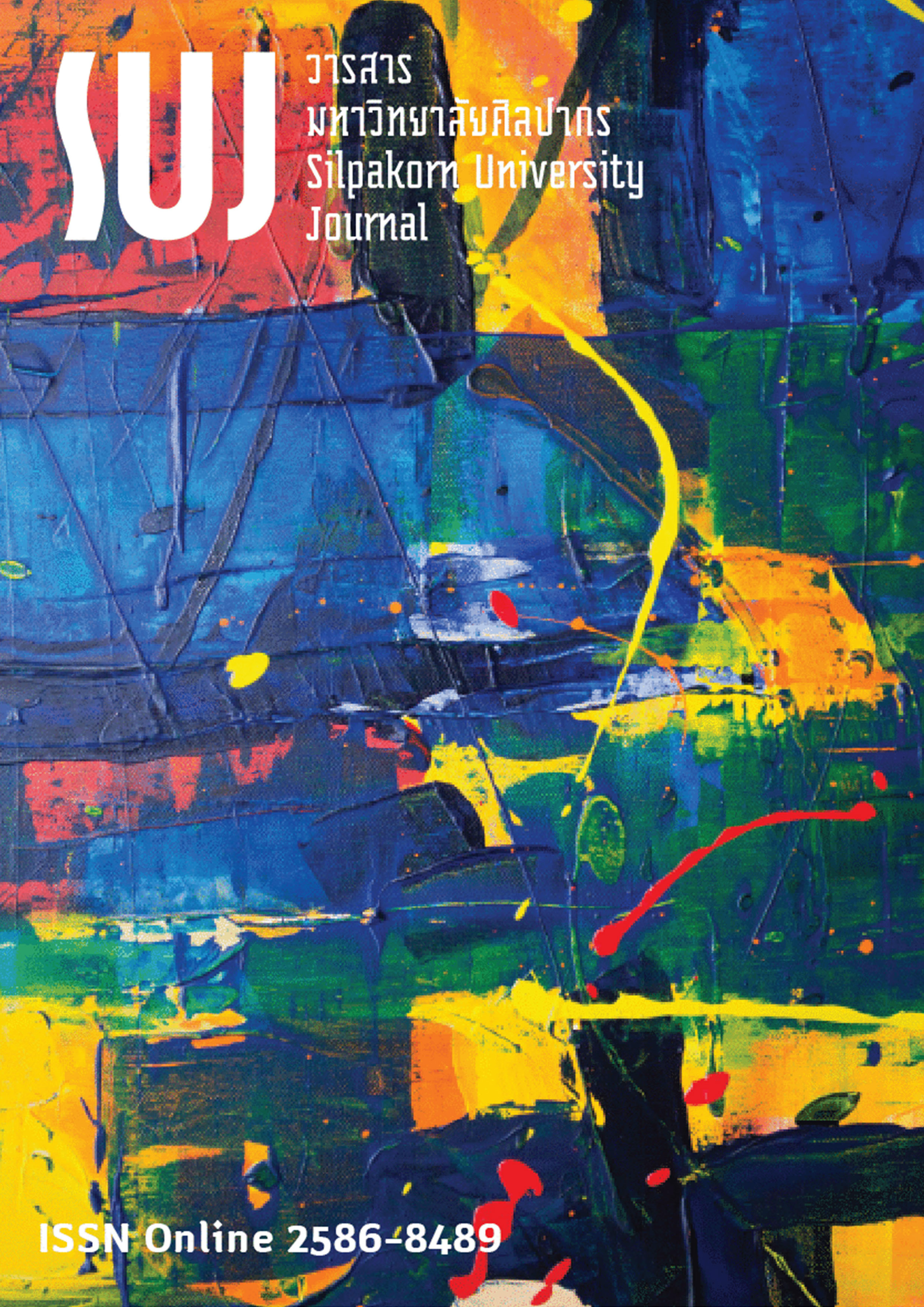พืช : อนุภาคในวรรณกรรมนิทานอีสานกับการศึกษาความหมายเชิงวัฒนธรรม (Plants: Motifs in isaan folktales and the study of cultural meanings)
Main Article Content
Abstract
บทความนี้มีวัตถุประสงค์ 1. เพื่อศึกษาบริบทวรรณกรรมนิทานอีสาน 2 ด้าน คือ ด้านความเป็นมาและด้านอนุภาคเกี่ยวกับพืช 2. เพื่อศึกษาพืชในวรรณกรรมนิทานอีสานกับความหมายเชิงวัฒนธรรม จากวรรณกรรมนิทานอีสาน 4 เรื่อง คือ 1. ขูลูนางอั้ว 2. ท้าวคัทธนาม 3. พญาคันคาก และ 4. พระลักพระลาม โดยวิธีพรรณนาวิเคราะห์ ผลการศึกษา ประการแรกด้านบริบทของวรรณกรรมนิทานอีสาน พบว่า 1) ด้านความเป็นมา ขูลูนางอั้วเป็นวรรณกรรมที่มีเนื้อหาในลักษณะของโศกนาฏกรรม ส่วนเรื่องท้าวคัทธนาม พญาคันคาก และพระลักพระลามมีเนื้อหาคล้ายกับชาดกและมีลักษณะเป็นนิทานสอนคติธรรม รวมถึงมูลเหตุอธิบายการกำเนิดสถานที่ต่าง ๆ 2) ด้านอนุภาคเหตุการณ์ที่เกี่ยวกับพืช มีบทบาทสำคัญทำให้ตัวละครหรือเหตุการณ์ใดเหตุการณ์หนึ่งพลิกผัน ส่งผลต่อการพัฒนาและการคลี่คลายท้องเรื่อง ส่วนประการที่สอง พืชในวรรณกรรมนิทานอีสานกับความหมายเชิงวัฒนธรรม พบว่า 1) พืช คือ สัญลักษณ์ของอำนาจธรรมชาติมีพลังอำนาจลบล้างความอหังการของมนุษย์ที่วางตนอยู่เหนือสรรพสิ่งทั้งปวง 2) พืช คือ สัญลักษณ์ของเสาค้ำฟ้า มีความลึกลับยากแก่การหยั่งรู้ และเป็นพืชที่เชื่อมระหว่างโลกสามัญกับโลกศักดิ์สิทธิ์ 3) พืช คือ สัญลักษณ์ของคติความเชื่อทางศาสนา ซึ่งสะท้อนให้เห็นความจริงอันประเสริฐ 4 ประการ หรืออริยสัจ 4 ซึ่งข้อค้นพบใหม่เกี่ยวกับพืชนั้น ทำให้เห็นว่า พืช คือ ภาพแทนของธรรมชาติที่มีพลังอำนาจ ลึกลับ ยากแก่การหยั่งรู้ของมนุษย์ และยากยิ่งที่มนุษย์จะสามารถควบคุมอำนาจนั้นได้ ฉะนั้นมนุษย์ควรตระหนักว่าไม่ควรเบียดเบียนธรรมชาติ เพราะเมื่อไรก็ตามที่ธรรมชาติแสดงพลังอำนาจนั้นออกมา นั่นก็คือภัยพิบัติของมวลมนุษยชาติ
The objectives of this article are 1. to study two aspects of Isaan folklores: backgrounds to the folklores and the plant motifs, and 2. to study the plant motif in Isaan folklores and their cultural meanings by using the descriptive analysis. The primary texts of this research are four Isaan floklores: 1. Khulu and Nang-Ua, 2. Thao Khanthanam, 3. Phaya Khan Khak, and 4. Phra Lak Phra Lam. The findings can be divided into two aspects. In terms of the backgrounds to the folklores, the study shows that Khulu and Nang Ua was written as a tragedy while Thao Khanthanam, Phaya Khan Khak, and Phra Lak Phra Lam are similar to stories in the Jatakas tales and they suggest moral lessons as well as some explanations about origins of places. In addition, the plant motifs in all the four selected folklores play important roles in making the turning points of the stories, and this contributes to the denouement of the stories. In terms of the connections between the plant motifs and their cultural meanings, the findings can be divided into three concepts. Firstly, plants symbolize environment that overpowers human beings who believe in anthropocentricism. Secondly, plants are the symbol of “the sky’s pillars,” which are mysterious and difficult to understand. They are also the connection between the secular world and the sacred world. Thirdly, plants are the symbol of religious beliefs. They suggest the noble truth or the four noble truths in Buddhism. These new findings on plants are indicative of the powerful and mystic power of plants that is beyond human understanding and human control. These results suggest that the folklores imply that humans should not take advantage of nature because they will never overcome the nature.
Downloads
Article Details

This work is licensed under a Creative Commons Attribution-NonCommercial-NoDerivatives 4.0 International License.
References
Chaonuam, Jaruwan. (2002). Lao Folktale : Characteristics and Relationship to Society (นิทานพื้นเมืองลาว : ลักษณะเด่นและความสัมพันธ์กับสังคม). Bangkok: Faculty of Arts, Chulalongkorn University.
Eambutrarob, Sukruedee. (1989). A Study of Phya Khankhaak, A Northeastern Thai Literary Work (การศึกษาวรรณกรรมอีสานเรื่อง พญาคันคาก). Master’s dissertation, Silpakorn University, Bangkok, Thailand.
Hongsuwan, Pathom. (2007). One Upon Time : On Myth and Culture (กาลครั้งหนึ่ง : ว่าด้วยตำนานกับวัฒนธรรม). Bangkok: Chulalongkorn University Press.
Kinsley, D. (2008). Ecology and Religion (นิเวศวิทยากับศาสนา). Translated by Supamantra, Laphaphan. Bangkok: Plan Printing.
Koanantakool, Paritta Chalermpow. (2003). The Sacred Worlds and Ordinary Worlds in Social Life (โลกศักดิ์สิทธิ์กับโลกสามัญในชีวิตทางสังคม). In Paritta Chalermpow Koanantakool (Ed.), Goddess, Grandfather, Chang Saw, Chang Fon, and Other Stories about rituals and dramas (เจ้าแม่ คุณปู่ ช่างซอ ช่างฟ้อน และเรื่องอื่น ๆ ว่าด้วยพิธีกรรมและนาฏกรรม), (pp. 2-7). Bangkok: The Princess Maha Chakri Sirindhon Anthropology Centre.
Na Thalang, Siraporn Thitathan. (2009). Folklore : Methodology in Myths - Folk Tales (ทฤษฎีคติชนวิทยา : วิธีวิทยาในตำนาน - นิทานพื้นบ้าน). Bangkok: Chulalongkorn University Press.
Namlao, Amporn. (1986). Thao Cut Thanam (ท้าวคัทธนาม). Nakhon Ratchasima: Cultural Center of Nakhon Ratchasima.
Pengplien, Phojanee. (1999a). Gajanam : Isan Tale Literature (ท้าวคัชนาม : วรรณกรรมนิทานอีสาน). In Thai Cultural Encyclopedia Northeastern Region 2nd (สารานุกรมวัฒนธรรมไทย ภาคอีสาน เล่ม 2), (pp. 1607-1616). Bangkok: Thai Cultural Encyclopedia Foundation, Siam Commercial Bank.
Pengplien, Phojanee. (1999b). Phra Lak Phra Lam : Isan Tale Literature (พระลักพระลาม : วรรณกรรมนิทานอีสาน). In Thai Cultural Encyclopedia Northeastern Region 9th (สารานุกรมวัฒนธรรมไทย ภาคอีสาน เล่ม 9), (pp. 3022-3031). Bangkok: Thai Cultural Encyclopedia Foundation, Siam Commercial Bank.
Pengplien, Phojanee. (1999c). Phraya Khankhak : Isan Tale Literature (พญาคันคาก : วรรณกรรมนิทานอีสาน). In Thai Cultural Encyclopedia Northeastern Region 9th (สารานุกรมวัฒนธรรมไทย ภาคอีสาน เล่ม 9), (pp. 2897-2900). Bangkok: Thai Cultural Encyclopedia Foundation, Siam Commercial Bank.
Phra Ariyanuwat. (1975). Phra Lak Phra Lam (พระลักพระลาม). Bangkok: Sathiangoset-Nakapratip Fund.
Phraya Prachakitjakornjak. (1930). Lan Xang Annals (พงศาวดารล้านช้าง). Phanakhon: Pittayakan.
Pintong, Precha. (1981). Khulu Nang-Ua (ขูลูนางอั้ว). Ubon Ratchathani: Siritham Offset.
Poonotoke, Dhawat. (1982). Regional Literature (วรรณกรรมท้องถิ่น). Bangkok: Odeon Store.
Poonotoke, Dhawat. (1999a). Gajanam : Isan Tale Literature (ท้าวคัชนาม : วรรณกรรมนิทานอีสาน). In Thai Cultural Encyclopedia Northeastern Region 2nd (สารานุกรมวัฒนธรรมไทย ภาคอีสาน เล่ม 2), (pp. 1616-1618). Bangkok: Thai Cultural Encyclopedia Foundation, Siam Commercial Bank.
Poonotoke, Dhawat. (1999b). Khulu Nang-Ua : Isan Tale Literature (ขูลูนางอั้ว : วรรณกรรมนิทานอีสาน). In Thai Cultural Encyclopedia Northeastern Region 2nd (สารานุกรมวัฒนธรรมไทย ภาคอีสาน เล่ม 2), (pp. 549-555). Bangkok: Thai Cultural Encyclopedia Foundation, Siam Commercial Bank.
Poonotoke, Dhawat. (1999c). Maneekot : Trees in Literature (มณีโคตร : ต้นไม้วรรณคดี). In Thai Cultural Encyclopedia Northeastern Region 10th (สารานุกรมวัฒนธรรมไทย ภาคอีสาน เล่ม 10), (pp. 3448). Bangkok: Thai Cultural Encyclopedia Foundation, Siam Commercial Bank.
Sangkhaphanthanont, Thanya. (2016). Contemporary Literary Theory (แว่นวรรณคดี ทฤษฎีร่วมสมัย). Pathum Thani: Nakhon.
Satyavadna, Chontira. (2018). Dam-Tan Born of the Tai State : Find the Root, Thai People, Tai-Laos Community and Thainess/Tai/Thai/Siam (ด้ำแถน กำเนิดรัฐไท :สาวรกรากต้นตอ คนไท ชุมชนไท-ลาวและความเป็นไทย/ไต/ไทย/สยาม). Bangkok: Chonniyom.
Sivasriyanon, Vit. (2001). Literary and Literary Criticism (วรรณคดีและวรรณคดีวิจารณ์). Bangkok: Dhammasat.
Thammawat, Jaruwan. (1994). Regional Literature: Isan-Lanxang (วรรณกรรมท้องถิ่น : อีสาน-ล้านช้าง). Mahasarakham: Mahasarakham University.


